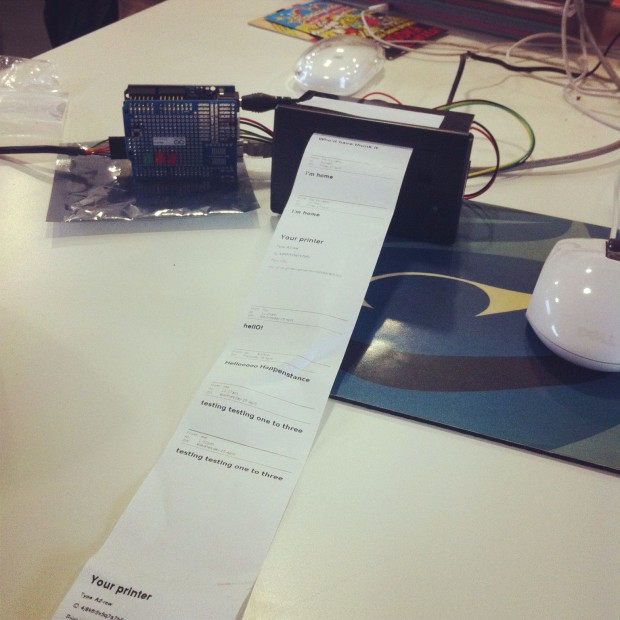
After an exciting start to the project last week, things really took off on Monday as Happenstance residents Kevin Walker and Linda Sandvik brought in a whole load of gadgets and spread them across the Associates Space. Linda shares what they’re working on, including two experiments that you can see at next weekend’s Spike Island Open:
We continued to play around with sensors and collecting data. Arduinos, Nanodes, IR sensors and a very pretty motion detection device from Maplin have been added to our kit. Kevin also started experimenting with how to present the data using Processing, a programming language developed specifically for artists (visual designers) – very well suited for the purpose! We are going to do a workshop on Processing for anyone who is interested sometime during our residency.
I am hoping to get some sort of skill swap going on, where people can hold workshops on something they know, and share their knowledge and expertise with the other people at Spike. Personally, I’d like workshops in letterpress and screen printing, and how to work the big scary machines down in the wood shop.
Every day I spend at Spike I fall a little bit more in love with the place. The building itself is a great source of inspiration, and there is a lot of potential in cross-pollination between the different departments/people here.
Kevin has started an Artists’ Postcard Swap project, with the theme “Wish You Were Here”, collaborating with 20 different artists at Spike and the former writer in residence. Postcards with RFID chips, that is. *Exciting*
I decided to have some new age fun with a vintage feel, and finally got my little Polaroid printer working over Bluetooth. People at Spike Island can send me pictures by email or using a specific hashtag on Twitter (#myspikeisland) that will automatically make the printer print out some small, low-quality stickers that will be put on display, sometime, somewhere.
You may have noticed that our plans are a bit loose still. This is fine. We may not know exactly where we are going with this, but in the meantime we keep on hacking, experimenting, playing around, and as we do our ideas develop and change.
We also visited Watershed and the wonderful Pervasive Media Studio where our minds were blown by some of the wonderful projects they’ve got going on. The bar has been raised.
While Kevin and Linda worked, I (Spike Island’s communications manager) headed up to Nottingham on Wednesday to take part in the Digital R&D Fund for Arts and Culture workshop where I heard about the other funded projects and shared what we’ve learned so far. Partnerships between cultural organisations and technology companies have resulted in a range of outcomes from a ticket-buying app for students by the London Symphony Orchestra to a new immersive way to experience Punchdrunk’s production Sleep No More online.
There was a lot of discussion about what research and development means: while for some of the technology partners it’s an essential element of their business, its place within arts organisations is a bit less clear. It was suggested that within the context of Happenstance the residents are perhaps more focused on process, while we as a staff team are (or at least feel) obliged to produce outcomes – we don’t usually spend months working on an exhibition and then decide not to do it! In a way, it’s true that we don’t always have the time, headspace or resources to do the sort of playful experimentation that Kevin and Linda have been invited to do here. On the other hand, maybe R&D should be seen as more of an ongoing thread of our work than a standalone activity. We certainly are always thinking, reading, talking and planning whilst actually delivering the programme, welcoming visitors and supporting a community of artists and designers.
Whichever way you look at it, my hope for the Happenstance residency is that it not only opens up the world of digital tools to us as a staff team, but that through this it inspires new ways of working and of seeing Spike Island for the whole organisation. Just today we’ve had a fantastic response from people across the building to Kevin and Linda’s invitation to participate in the projects described by Linda above!











